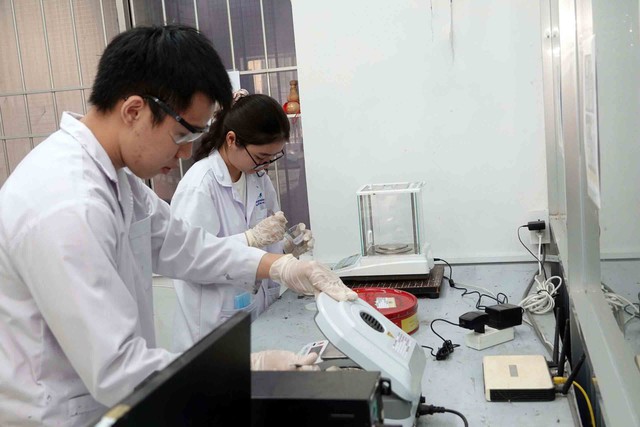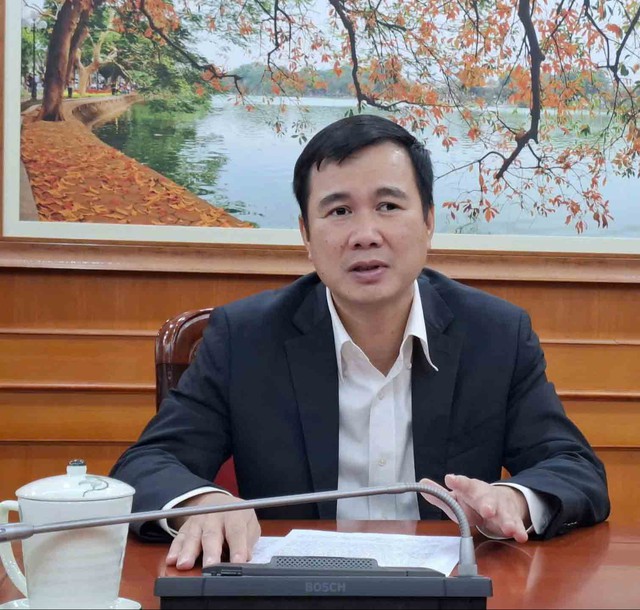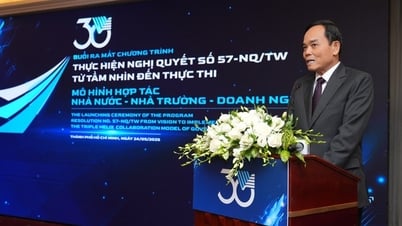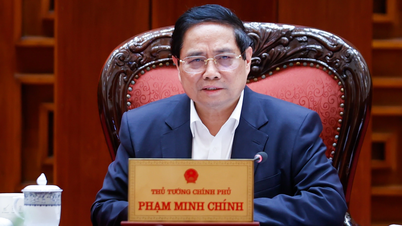On December 22, 2024, General Secretary To Lam signed and issued Resolution No. 57-NQ/TW (NQ57) on breakthroughs in science and technology (S&T) development, innovation and national digital transformation.
Responding to Thanh Nien , Deputy Minister of Science and Technology Bui The Duy commented that Resolution 57 is a breakthrough spearhead, focusing on removing institutional bottlenecks, to liberate the creativity, labor, and investment resources of the whole society for science and technology, innovation, and digital transformation.

Chemical engineering students do scientific research at Ho Chi Minh City University of Technology
PHOTO: DAO NGOC THA
Shows many new perceptions, new perspectives
This is not the first time the Central Committee has issued a resolution on science and technology development, but with Resolution 57, we can see the enthusiastic reception of the science and technology community. Why do you think there is such optimism?
Deputy Minister of Science and Technology Bui The Duy: In my opinion, we have grounds for optimism because Resolution 57 has demonstrated the new perceptions and viewpoints of the Politburo on science and technology development, innovation, and digital transformation (hereinafter referred to as science and technology). For example, the viewpoint of investing in science and technology is defined as long-term investment, not short-term investment. Long-term investment means accepting risks, accepting delays, not just investing and then recovering capital immediately. We raise the issue of creating a controlled testing mechanism, accepting risks in science, in testing new technologies. This is a very new issue, especially in the era of digital transformation.
Another important viewpoint of Resolution 57 is to determine that investment in science and technology is mandatory in the current period, to turn Vietnam into a developing country with modern industry and high average income by 2030; and a developed country with high income by 2045. Then there are viewpoints related to promoting public-private cooperation, cooperation between universities, public research institutes and enterprises; calling for resources, liberating investment resources of society and enterprises for digital infrastructure, telecommunications infrastructure, research and development infrastructure, etc.
Another viewpoint that is very up to date with the current era to catch up with the world 's development trend in science and technology: considering data as a new resource, data as a new source of production materials; digital transformation is to innovate production and business methods, to innovate production forces. Resolution 57 also points out institutional bottlenecks when it has not attracted talent and high-quality experts at home and abroad. Then it requires removing bottlenecks in legal issues on public investment, public procurement, and intellectual property of research results from research topics funded by the state budget.
Many other new viewpoints have been expressed in Resolution 57. But what makes the science and technology community most excited to welcome Resolution 57 is the resolution's high action nature. That action nature is reflected in the requirements to review and restructure the system and public science and technology organizations; merge and dissolve weak organizations that are not operating effectively, so that investment has a focus. The highlight in Resolution 57's action nature is the requirement to build and deploy strategic technology, in the requirements related to the development of digital infrastructure, telecommunications infrastructure, 5G coverage, development of artificial intelligence technology, IoT (Internet of Things)... The action nature of Resolution 57 is very clear and very drastic.
Resolution 57 is meant as a call for all forces, from state management officials to scientists, technology workers, to businesses... to re-evaluate themselves and change themselves to meet the country's requirements in the new situation.
Must change working speed
But a resolution itself cannot be a "magic wand" if the instructions in the resolution are not fully implemented in practice. Meanwhile, up to now, not all instructions of the Party and State have been implemented as expected. What do you think?
Yes, the Politburo's issuance of Resolution 57 is a welcome start. However, the challenges ahead are huge, many. The first is how to put the resolution into practice. The second is the speed and time of implementing the resolution. We live in an era where the world is developing very quickly. If the resolution is not implemented quickly, its content will quickly become outdated. The third challenge is how to widely implement it to the entire population and society.
What is the solution to the above challenges, sir?
To solve the above challenges, first of all, the state management staff must change their working style, work at a higher speed, then there will be new solutions to quickly concretize the requirements of the resolution into institutions. It cannot be like before, that is, we amend laws, amend decrees, amend circulars by year. The speed now must be by month. The implementation of projects and proposals, which could be done by month in the past, now must be done by week. To solve the challenges, first of all, is the story of each cadre, each party committee.
The spirit of the resolution must be thoroughly understood and put into concrete action for all managers, all party members, all committees, and then for all enterprises and all members of the science and technology community. If it is only implemented in a few departments or implemented in a few areas, it will not create a spread. The action in Resolution 57 is revolutionary, and the revolution must be simultaneous, at a very high speed, to create sudden changes.
To create a revolution, every individual must change the way they work. Change based on digital transformation, working based on data, working with automation systems, artificial intelligence systems; need new skills such as data accumulation skills, data analysis...
Digital transformation can be roughly understood as the application of digital technology plus innovation. The application of digital technology is the development of science and technology, the development of infrastructure platforms... It is a change in management methods, in working methods and processes. We cannot have an e-government system without simplifying administrative procedures. If administrative procedures are still cumbersome, still go through many stages, each ministry, branch, department, and office has its own part to participate in, without decentralization, then no IT system can meet the requirements.
Many advantages
But do we also have certain advantages in implementing NQ57?
Obviously, we have many advantages. The most obvious advantage is our political system. According to Resolution 57, General Secretary To Lam is the Head of the Central Steering Committee on Science and Technology Development, Innovation and Digital Transformation. The Politburo will preside over the implementation of this resolution on January 13 at Dien Hong Hall. With the special attention of the Politburo to the development of science and technology, the entire political system will be imbued with the spirit of the resolution and participate with the highest sense of responsibility.
But we have many other advantages. That is Vietnam's current position in the international arena. Vietnam has signed 16 free trade agreements (FTAs), including many new generation FTAs with deep and comprehensive commitments, with stricter enforcement mechanisms; and when effective, they will have a strong impact on Vietnam's economic growth rate and institutions.
We currently have diplomatic relations with 193 countries in the world, including strategic partnerships and comprehensive partnerships with 30 countries; economic relations with more than 230 countries and territories. We have comprehensive strategic partnerships with 9 countries. This position is an advantage for us when implementing Resolution 57.
The third advantage is that we have a strong human resource base, with a foundation in IT, mathematics, and engineering. These factors greatly facilitate the development of science and technology, especially digital technology at the present stage. The next advantage is that we have a large market, which is a "midwife" for science and technology products and digital transformation products. Finally, our geopolitical advantage in the region makes connection and exchange convenient, creating a premise for development.

PHOTO: QUY HIEN
Currently, the promotion of science and technology development, innovation, and digital transformation is still implemented according to Resolution No. 20-NQ/TW, Conclusion No. 69-KL/TW, and Resolution No. 52-NQ/TW of the Politburo. These are comprehensive and overall instructions. Resolution 57 focuses on institutional bottlenecks and provides viewpoints and mechanisms to resolve long-standing shortcomings in science and technology development, innovation, and digital transformation. For the first time, science and technology, together with innovation, and digital transformation, are placed in the position of "the most important breakthrough". Science and technology, innovation, and digital transformation are the three main pillars for national development in the new era.
Deputy Minister of Science and Technology Bui The Duy
Goals in Resolution 57
By 2030
- Vietnam is in the top 3 countries in Southeast Asia, the top 50 countries in the world in terms of digital competitiveness and e-government development index; the top 3 countries in Southeast Asia in research and development of artificial intelligence; the center for developing a number of digital technology industries and fields in which Vietnam has advantages. There are at least 5 digital technology enterprises on par with advanced countries.
- The contribution of total factor productivity (TFP) to economic growth is over 55%; the proportion of high-tech product exports to the total value of exported goods reaches at least 50%. The scale of the digital economy reaches at least 30% of GDP. The rate of online public service use by people and businesses reaches over 80%; non-cash transactions reach 80%. The rate of enterprises with innovative activities reaches over 40% of the total number of enterprises.
- Research and development (R&D) expenditure reaches 2% of GDP, of which social expenditure accounts for more than 60%. Allocate at least 3% of total annual budget expenditure for science and technology development, innovation, national digital transformation and gradually increase according to development requirements.
Human resources for scientific research, technology development, and innovation reach 12 people per 10,000 people; there are 40-50 science and technology organizations ranked regionally and globally; the number of international scientific publications increases by an average of 10% per year; the number of patent applications and patent protection certificates increases by an average of 16-18% per year; the commercial exploitation rate reaches 8-10%.
- Advanced and modern digital technology infrastructure on par with advanced countries; gradually mastering a number of strategic technologies and digital technologies such as: artificial intelligence, internet of things (IoT), big data, cloud computing, blockchain, semiconductors, quantum technology, nano, 5G, 6G mobile information, satellite information, etc.
Nationwide 5G coverage. Complete smart urban construction for centrally-run cities and some qualified provinces and cities. Attract at least 3 more leading technology organizations and enterprises in the world to set up headquarters, invest in research and production in Vietnam.
- Developing digital government, digital economy, digital society, digital citizens, and digital cultural industry to reach world-class levels.
By 2045:
- Vietnam has a digital economy scale reaching at least 50% of GDP; is one of the digital technology industry centers of the region and the world; belongs to the group of 30 leading countries in the world in innovation and digital transformation.
- The rate of digital technology enterprises is equivalent to that of developed countries. There are at least 10 digital technology enterprises on par with advanced countries.
- Attract at least 5 more leading technology organizations and enterprises in the world to set up headquarters, invest in research and production in Vietnam.
Le Hiep
Source: https://thanhnien.vn/be-phong-de-vn-phat-trien-khoa-hoc-cong-nghe-185250112232342857.htm




![[Photo] Ho Chi Minh City holds funeral for former President Tran Duc Luong](https://vphoto.vietnam.vn/thumb/1200x675/vietnam/resource/IMAGE/2025/5/24/9c1858ebd3d04170b6cef2e6bcb2019e)


![[Photo] The Government Standing Committee works with ministries and branches on the real estate market situation.](https://vphoto.vietnam.vn/thumb/1200x675/vietnam/resource/IMAGE/2025/5/24/e9b5bc2313d14c9499b8c9b83226adba)






















![[Photo] Party and State leaders visit former President Tran Duc Luong](https://vphoto.vietnam.vn/thumb/1200x675/vietnam/resource/IMAGE/2025/5/24/960db9b19102400e8df68d5a6caadcf6)





























































Comment (0)